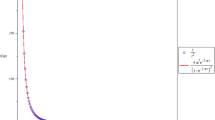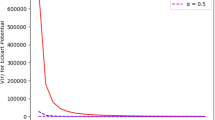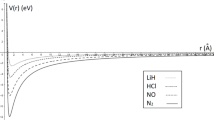Abstract
We obtained an approximate solution of the Schrodinger equation for the modified Kratzer potential plus screened Coulomb potential model, within the framework of Nikiforov–Uvarov method. The bound state energy eigenvalues for N2, CO, NO, and CH diatomic molecules were computed for various vibrational and rotational quantum numbers. Special cases were considered when the potential parameters were altered, resulting into modified Kratzer potential, screened Coulomb potential, and standard Coulomb potential, respectively. Their energy eigenvalues expressions and numerical computations agreed with the already existing literatures.





Similar content being viewed by others
References
H Hassanabadi, E Magshoodi and S Zarrinkamar Few-Body Syst.53 271 (2012)
R Sever, C Tezan, O Yesiltas and M Bucurgat Int. J. Theor. Phys.49 2243 (2008)
A N Ikot, L E Akpabio and E B Umoren J. Sci. Res.3 25 (2011)
O Bayrak and I Boztosun Phys. Scri.76 92 (2007)
H Egrifes, D Demirhan and F Buyukkilic Phys. Lett. A.275 229 (2000)
S M Ikhdair and R Sever Ann. Phys.18 189 (2009)
C Onate, K Oyewumi and B Falaye Few-Body Syst.55 61 (2014)
M Hamzavi, K E Thylwe and A Rajabi Commun. Theor. Phys.60 1 (2013)
S M Ikhdair and B J Falaye Chem. Phys.421 84 (2013)
C Y Chen, F L Lu and D S Sun Cent. Eur. J. Phys.6 884 (2008)
C Pekeris Phys. Rev.45 98 (1934)
W C Qiang and S H Dong Phys. Lett. A.363 169 (2007)
C Berkdemir and J Han Chem. Phys. Lett.409 203 (2005)
S H Dong Factorization Method in Quantum Mechanics (Armsterdam: Springer) (2007)
J Y Liu, G D Zhang and C S Jia Phys. Lett. A.377 1444 (2013)
H M Tang, G C Liang, L H Zhang, F Zhao and C S Jia Can. J. Chem.92 341 (2014)
C S Jia and Y Jia Eur. Phys. J. D.71 3 (2017)
A N Ikot, H P Obong, T M Abbey, S Zare, M Ghafourian and H Hassanabadi Few-Body Systems (Berlin: Springer) (2016)
C A Onate, M C Onyeaju, A N Ikot and J O Ojonubah Chin. J. Phys.000 1 (2016)
C A Onate, A N Ikot, M C Onyeaju and M E Udoh Karbala Int. J. Modern Sci.3 1 (2017)
A N Ikot, O A Awoga, A D Antia, H Hassanabadi and E Maghsodi Few-Body Syst.54 2041 (2013)
H Ciftci, R L Hall and N Saad J. Phys. A: Math. Gen.36 11807 (2003)
B J Falaye Cent. Eur. J. Phys.10 960 (2012)
M R Setare and E Karimi Phys. Scri.75 90 (2007)
W C Qiang and S H Dong Eur. Phys. Lett.45 10003 (2010)
S M Ikhdair and R Sever J. Math. Chem.45 1137 (2009)
G Chen Phys. Lett. A.326 55 (2004)
C Berkdemir J. Math. Phys.46 13 (2009)
C Tezcan and R Sever Int. J. Theor. Phys.48 337 (2009)
A N Ikot, I O Akpan, T M Abbey and H Hassanabadi Commun. Theor. Phys.65 569 (2016)
C A Onate and J O A Idiodi Chin. J. Phys.53 7 (2015)
A N Ikot, O A Awoga, H Hassanabadi and E Maghsodi Commun. Theor. Phys.61 457 (2014)
B J Falaye, K J Oyewumi and M Abbas Chin. Phys. B22 110301 (2013)
A D Antia, A N Ikot, H Hassanabadi and E Maghsodi Indian J. Phys.87 1133 (2013)
A Kratzer Z. Phys.3 289 (1920)
J Sadeghi Acta Phys. Pol.112 23 (2007)
R J Le Roy and R B Bernstein J. Chem. Phys.52 3869 (1970)
O Bayrak, I Boztosun and H Cifti Int. J. Quant. Chem.107 540 (2007)
N Saad, R J Hall and H Cifti Cent. Eur. J. Phys.6 717 (2008)
H Hassanabadi, H Rahimov and S Zarrinkamar Adv. High Energy Phys.458087 1 (2011)
S Dong, G H Sun and S H Dong Int. J. Mod. Phys. E22 1350036 (2013)
S M Ikhdair and R Sever J. Mol. Struct: Theochem.809 103 (2007)
E Z Liverts, E G Drukarev, R Krivec and V B Mandelzweig Few-Body Syst.44 367 (2008)
E Maghsoodi, H Hassanabadi and O Aydodu Phys. Scri.86 015005 (2012)
J P Edwards, U Gerber, C Schubert, M A Trejo and A Weber Prog. Theor. Exp. Phys.0873A01 1 (2017)
C A Onate and J O Ojonubah J. Theor. Appl. Phys.10 21 (2016)
H Hamzavi, M Movahedi, K E Thylwe and A A Rajabi Chin. Phys. Lett.29 080302 (2012)
A N Ikot, E O Chukwuocha, M C Onyeaju, C N Onate, B I Ita and M E Udoh Pramana J. Phys.90 22 (2018)
L H Zhang, X P Li and C S Jia Int. J. Quant. Chem.111 1870 (2011)
R L Greene and C Aldrich Phys. Rev. A14 2363 (1976)
M Abramowitz and I A Stegun Handbook of Mathematical Functions with Formulas, Graphs and Mathematical Tables (New York: Dover) (1964)
C Birkdemir Application of the Nikiforov–Uvarov Method in Quantum Mechanics Theor. Concept Quant. Mech. (ed.) M R Pahlavani Chapter 11 (2012)
C Berkdemir, A Berkdemir and J Han Chem. Phys. Lett.417 326 (2006)
H Hassanabadi, E Maghsoodi, S Zarrinkamar and H Rahimov Chin. Phys. B12 120302 (2012)
E Maghsoodi, H Hassanabadi, H Rahimov and S Zarrinkamar Chin. Phys. C37 043105 (2013)
H Hassanabadi, E Maghsoodi and S Zarrinkamar Chin. Phys. C37 113104 (2013)
U S Okorie, E E Ibekwe, A N Ikot, M C Onyeaju and E O Chukwuocha J. Kor. Phys. Soc.73 1211 (2018)
U S Okorie, A N Ikot, M C Onyeaju and E O Chukwuocha Rev. Mex. de Fis.64 608 (2018)
U S Okorie, A N Ikot, M C Onyeaju and E O Chukwuocha J. Mol. Mod.24 289 (2018)
X L Peng, R Jiang, C S Jia, L H Zhang and Y L Zhao Chem. Eng. Sci.190 122 (2018)
C S Jia, C W Wang, L H Zhang, X L Peng, H M Tang, J Y Liu, Y Xiong and R Zeng Chem. Phys. Lett.692 57 (2018)
R Jiang, C S Jia, Y Q Wang, X L Peng and L H Zhang Chem. Phys. Lett.715 186 (2019)
C S Jia, C W Wang, L H Zhang, X L Peng, H M Tang and R Zeng Chem. Eng. Sci.183 26 (2018)
C S Jia, R Zeng, X L Peng, L H Zhang and Y L Zhao Chem. Eng. Sci.190 1 (2018)
A F Nikiforov, V B Uvarov Special Functions of Mathematical Physics (ed.) A Jaffe (Germany: Birkhauser Verlag Basel) p 317 (1998)
Author information
Authors and Affiliations
Corresponding author
Additional information
Publisher's Note
Springer Nature remains neutral with regard to jurisdictional claims in published maps and institutional affiliations.
Appendix: Review of Nikiforov–Uvarov (NU) method
Appendix: Review of Nikiforov–Uvarov (NU) method
The NU method was proposed by Nikiforov and Uvarov [65] to transform Schrodinger-like equations into a second-order differential equation via a coordinate transformation \( s = s(r), \) of the form
where \( \tilde{\sigma }(s),\,\,\sigma (s) \) are polynomials, at most second degree and \( \tilde{\tau }(s) \) is a first-degree polynomial. The exact solution of Eq. (41) can be obtained by using the transformation
This transformation reduces Eq. (41) into a hypergeometric-type equation of the form
The function \( \varPhi (s) \) can be defined as the logarithm derivative [65]
with \( \pi (s) \) being at most a first-degree polynomial. The second part of \( \psi (s) \) being \( y_{n} (s) \) in Eq. (42) is the hypergeometric function with its polynomial solution given by Rodrigues relation
Here, \( B_{n} \) is the normalization constant and \( \rho (s) \) is the weight function which must satisfy the condition
with
It should be noted that the derivative of \( \tau (s) \) with respect to s should be negative. The eigenfunctions and eigenvalues can be obtained using the definition of the following function \( \pi (s) \) and parameter \( \lambda \), respectively:
and
The value of \( k \) can be obtained by setting the discriminant of the square root in Eq. (48) equal to zero. As such, the new eigenvalue equation can be given as
Rights and permissions
About this article
Cite this article
Edet, C.O., Okorie, U.S., Ngiangia, A.T. et al. Bound state solutions of the Schrodinger equation for the modified Kratzer potential plus screened Coulomb potential. Indian J Phys 94, 425–433 (2020). https://doi.org/10.1007/s12648-019-01477-9
Received:
Accepted:
Published:
Issue Date:
DOI: https://doi.org/10.1007/s12648-019-01477-9




